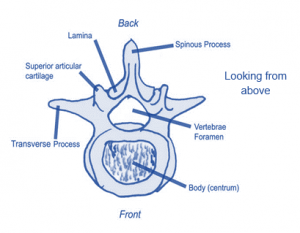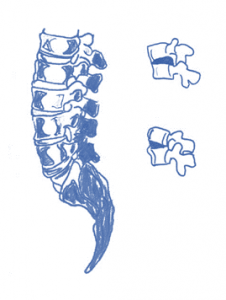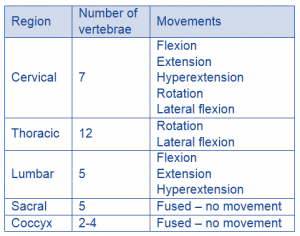Structure of a vertebra
Apart from the upper two vertebrae (the atlas and axis), all vertebrae have the same basic structure. Each vertebra consists of two parts:
- A vertebral body, known as the centrum
- A neural arch
Click to enlarge
Each vertebral body increases in size from the cervical vertebrae to the lumbar vertebrae, in order to support the weight of the body. The neural arch allows muscles to attach via the spinous (rear) and tranverse (side) processes, and the articular processes link onto adjacent vertebrae.
The inferior and superior articular processes are paired processes protruding downward and upward, respectively from the side. The joint surfaces of the articular processes are called facets and are covered with hyaline cartilage. The inferior articular processes of each vertebra form gliding synovial joints (called facet joints) with the superior articular processes of the vertebra immediately below. Therefore, successive vertebrae join both at their bodies and at their articular processes.
Any variations to the basic structure of a typical vertebra, tend to be functional and regional in origin.
In the cervical region, the vertebrae are smaller and lighter. They also allow a wide range of movement and have a large vertebral canal as the spinal cord is thick in this region.
A bit lower down, in the thoracic region, the vertebrae are adapted to form joints with the ribs.
In the lumbar region, the vertebrae are large to withstand the weight of the trunk above. They also allow a relatively small range of movement and have a smaller vertebral canal, as the spinal cord is much smaller at this level.
The sacrum consists of 5 bones which are fused together to form a solid triangular structure, and the coccyx comprises 4 fused bones, and is the lowest part of the vertebral column.
In between each pair of vertebrae there exists a disc of fibro-cartilage. This disc is a very tough and resilient tissue, whose function is to allow a small amount of movement between the vertebrae and to absorb shock.
The vertebral column forms four curves. The cervical and lumbar curves are convex, while the thoracic and sacral curves are concave.
These curves help to increase the strength of the structure, as well as acting like a spring and absorbing shocks or impacts – thus helping to reduce the risk of injury.
It is important to maintain correct spinal curvature at the cervical, thoracic and lumbar vertebrae in order to:
- Prevent joint and ligament damage within the vertebral column
- Perform weight-bearing exercise and biomechanical efficiency
- Allow the transmission of stresses safely and efficiently through the pelvis, caused by impact
The vertebral column is supported and stabilised by bands of ligaments stretching along the column at the front (anterior) and back (posterior). The posterior ligament is relatively weak and can be damaged with excessive movement. There are also many short ligaments in between each vertebra which can also be damaged with excessive movement. One reason why unsupported flexion of the vertebral column during exercise is not advised.
As discussed above, the spine is naturally curved to absorb impact and is made of 33 vertebrae with discs of cartilage between which also act as shock absorbers when the spine moves. The movement allowed at the each region of the spine is outlined below:
When the spine moves, stress is placed on the discs – flexion places pressure on the front, lateral flexion at the side, and extension places stress on the back of the discs. It is important that care should be taken when moving the spine to reduce excessive and overly repetitive movement that will over-stress the vertebral discs, potentially causing interference to nervous system transmissions if a nerve is trapped.
Correct posture also ensures the spine is adequately aligned and the pressure on the discs is equal. Incorrect posture causes unnecessary pressure on the discs which may in time contribute to back pain, reduced mobility and stability.





